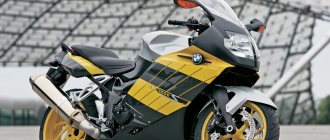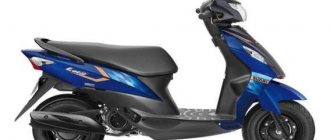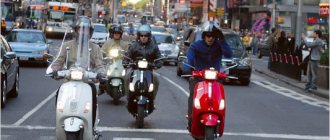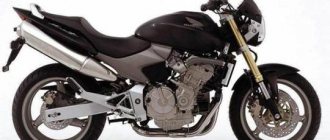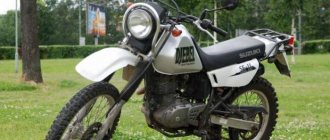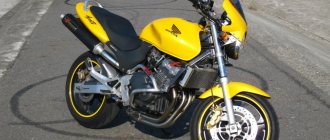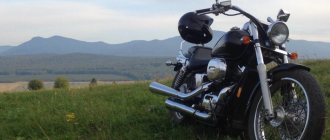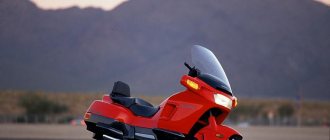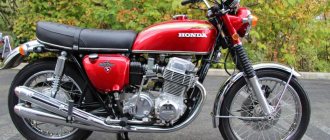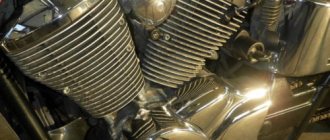- Honda motorcycle model
The Honda CRM 250 R enduro model appeared in 1989 as a simple two-stroke motorcycle aimed at public roads. According to the classification, the Honda CRM250 belongs to the soft-enduro class - soft suspension, balanced engine settings, low fuel consumption - all this makes the motorcycle ideal for leisurely riding on rough terrain, dirt roads and forests.
The first generation of the model, 1989-1990, was distinguished by the presence of a conventional fork and a maximum engine power of 37 hp. The engine was equipped with a balancer shaft and power valves that changed the intake and exhaust cross-sections for smoother thrust and optimized engine performance throughout the entire speed range. Foreign sources call this generation of the motorcycle MK1.
By March 1991, Honda introduced a new generation of the Honda CRM250, dubbed MK2 by consumers. Instead of the usual 41mm telescopic fork, the model gets an inverted fork with a 45mm stanchion diameter and adjustability. The rear shock absorber increases its travel from 280 to 300 mm. The frame structure is strengthened by thickening the pipes. The engine receives a new PGM-RC power valve system, which digitally controls the exhaust cross-section depending on engine speed. In addition, the model receives a new exhaust, a more advanced combustion chamber and intake system - all changes were aimed at improving engine performance in the low and medium speed zone. Starting with this generation, maximum power increases to 40 hp and torque from 33 to 36 Nm at the same operating speed. New, more advanced ignition system - PGM-DC-CDI. The engine compression ratio increases - from 6.2 to 6.4.
This generation also received the following small changes:
Increased cooling radiator capacity.
More durable pierced.
Minor changes to the clutch.
The brake discs have increased strength, and the rear brake pedal has become more productive. The power of the lamps in the turn signals increased from 10 to 15 W. At the beginning of 1993, the model received minor changes regarding the shape of the brake and clutch levers, the clutch cable (now made of stainless steel), the wheels (now slightly lighter), and the color scheme (now the fenders and saddle are the same color).
By the beginning of 1994, the Honda CRM250R model was updated again - the MK3 generation. The exhaust system is changed, which increases the torque characteristics from 36 to 39 Nm. The compression ratio increases again - from 6.4 to 6.7. The gear ratio of 1st and 2nd gears changes (become longer). The light switching system has been changed (to improve starting characteristics, the light turns on only after the engine reaches idle speed). The oil tank has been moved to the rear of the cylinder (to optimize weight distribution and improve serviceability). The rear suspension design has been changed (the shock absorber diameter has been increased from 44 to 46 mm), and the remote reservoir has been moved. The fuel tank capacity was increased from 10 to 11 liters.
Since January 1997, Honda has offered a new and final generation of the CRM250 model. The model changes its name - Honda CRM250AR. The motorcycle is equipped with a new engine of increased volume (246 → 249 cm³) and a new carburetor - fuel efficiency increases by 32%, reducing harmful CO² emissions by 50%. The engine becomes even more flexible. The rigidity of the frame and chassis has increased (the suspension configuration has been optimized for more comfortable driving on bad roads). The power of the headlight increases (35/36.5W → 55/60W). New unique motorcycle livery and AR stickers.
<AR 2-Stroke Engine Technology>
The main principle of AR technology is to improve the combustion of the fuel mixture in all engine operating modes, especially at moments of minimal load (slight throttle opening), when some of the fuel simply does not have time to burn. AR technology involves the use of the phenomenon of self-ignition (when a flash of the fuel-air mixture occurs without the participation of a spark plug), I control this process with a special ARC valve installed on the exhaust. This valve changes the ignition timing, controls the remaining unburnt mixture in the cylinder and the initial pressure. As a result, the use of this system significantly increases fuel efficiency and engine efficiency, and reduces harmful emissions.
1999 was the last year of production of the Honda CRM250 model, after which it finally left the market and did not receive further development. Tightening environmental standards forced motorcycle manufacturers to abandon civilian (non-sports) motorcycles with 2-stroke engines, even though the technology of that time already made it possible to build 2-stroke engines with a long service life, good fuel efficiency, environmental friendliness and, at the same time, , simplicity and high output characteristics, not inferior to highly accelerated 4-stroke versions (which had a short resource and high maintenance costs).
Motorcycle history
Honda began producing the 250 back in 1989, so this bike can easily be called a motorcycle with history. Until the 90s, a model with the CRM250R nomenclature was produced. This example featured a conventional telescopic fork and 37 horsepower.
Over the next two years, from 1191 to 1993, the Honda CRM 250 introduced a new engine management system. The programmed fuel injection system provided good fuel economy at maximum engine power. The maximum figure with a torque of 36 nM increased to 40 horsepower. The inverted fork added stability to the model, and the shock absorber smoothed out bumps in the road.
From 1994 to 1996, an improved enduro model went on sale, which boasted a new and improved engine. It was more sensitive to steering and pulled better at the bottom, and torque was under 40 nm. The capacity of the fuel tank has also increased.
The last series was released in 1997-1999. The engine has become two-stroke, more economical and environmentally friendly. Its emissions have been reduced by half compared to previous versions. The appearance has also undergone changes: the headlight power has been increased and the design has been improved.
In 1999, the last model of the Honda 250 was released. Despite this, the motorcycle is still incredibly popular in Russia. With proper handling and timely repairs, it is not inferior to modern models in technical and external characteristics.
I will take the liberty to share with you, dear regulars and guests of BIKEPOST, impressions based solely on personal operating experience, and trustworthy information gleaned from specialized forums, and in no way claiming to be the ultimate truth.
HONDA CRM 250 AR, 2-stroke sports, tough enduro from the late 90s of the last century, interspersed with “how did I get to this point in life” and “I think so…” During the unfolding crisis, I think there is an interest in technology those years will increase. I don’t consider their products as an alternative to Chinese ones under heavy loads, as long as their products are only for light users. It’s also relevant for those who believe that moving on two wheels, in the boundless chaos of public roads, is associated with an unjustified risk. I was prompted to buy this motorcycle by what happened at the beginning of the season, a rather hard lowside at a speed of about 100 km/h, which led not to sliding, but to somersaulting on the asphalt. And as a result (you can’t buy health, as they say), the decision to give up a dangerous activity. But by winter, somehow the memories of the injuries were forgotten, and the memory of how a wave of adrenaline, endorphins and enkephalins hit the edge of the skull was quite fresh. After some thought, I decided that if I didn’t drive through special roads, the risk of scratching my body would be significantly reduced, and after smoking hundreds of pages of forums (there was such a topic for 130 pages), a compromise was found between remaining intact and tasting the forbidden fruit - that is, CRM. The motivation was based on the fact that, according to additional regulations, some part of the path will need to be overcome with caution, and you can’t avoid a gas station, therefore, a PTS is necessary, sufficient power, maintainability (this is not a 4-stroke engine, although their resource is the same, in practice it is far from what is written in the manual, and often differs tenfold), not whimsical, reliable, etc. I wanted the AR, and not the R, which is much cheaper, well, this is a whim, I have a right, in my old age. I took my time looking, there were almost no options. But somehow everything worked out and I bought it. As the seller flew right up to it, in January, with sliding according to additional access points, I was simply dumbfounded. It turned out to be expensive, but there were no options, but I really wanted it. I haven’t regretted it even once, maybe once or twice. I started riding it in the winter, bought it on a studded “five”, with studs from trucks and cars, on the road next to the parking lot, and little by little it “settled” (as it turned out later it was not correct). As it dried out, I drove out on the floor of an abandoned cross-country track. The first lift off the ground is something, 20 centimeters, but it seems that you flew into space, if in your soul you are a pilot, the first time and forever, in general, by the end of the season I successfully bent the explosive, my heart was pounding against my ribs for about 10 minutes . They immediately told me that enduro was not suitable for cross-country, but it was not specific, not convincing, but I also did not know what to expect from riding on the track. Now I see it this way - the weight distribution is different, which means a smaller angle of inclination when turning, a less comfortable position when jumping out, due to the wider saddle it is not convenient to hold the bike with your feet, the suspension is softer when undershooting and overflights there are noticeable breakdowns (but I’m heavy 105 kg., so for 70, maybe normal), when transferring the body to the tank before turning, it’s not comfortable, well, that’s all, so if you don’t live on a cross-country track, but use it for training, then CRM is what the doctor ordered . The engine is a song, at the start it did not lag behind the cross-country 4-stroke 250s, a significant difference from the 4-stroke, less predictably flat in the middle of the rev range. Resource - there are legends that someone rode 50 thousand, but 20 for sure, on one well-known forum, there is a topic with a name almost like my topic, where a rider talked about a two-week trip to Kazakhstan - 5,000 km. There are no Japanese spare parts, they have been discontinued, they partially fit with a tambourine with the CR 250, for some reason they are still produced for them, the Celestial Empire helped out, they have started producing the piston group. Leaf valve - you can make it yourself, it’s not difficult. Fork from CR 250 1990. Wheels from XR. The only real reason to run into money is oil starvation - especially careful ones turn oil into gasoline, a little inconvenient, but reliable. If maintenance is not done in a timely manner, the power valve gets dirty and limited, and as a result, the brain burns, which is treated in Novokuznetsk. I started it at -34, without any problems. I rode the Drzeta - it doesn’t go, the XP 250 doesn’t go at all. Gasoline consumption in training mode is ten. The cylinder coating is nikosil, that is, it cannot be sharpened, but it is also difficult to obtain output; only the piston with rings is changed, which is convenient, neither the valves nor the chain. The suspension is rather weak compared to the cross-country suspension, but for long off-road rides it is much more comfortable, everything is adjustable, on the CRF I set everything to minimum, it hurts my palms differently. If we compare it with the XP 250, it seemed to me that the front shock absorber does not work at all... The brakes are the same as the CRF 450, a feature of 2-stroke bikes, there is no engine braking, so the brake is constantly applied. On special stages, on cross-country tires, it is extremely unstable over a hundred, but on the markings on the Moscow Ring Road, it generally rearranges. On SM wheels it’s excellent, the steering wheel is 15 centimeters wider, which is critical in the row-spacing, short gears are on the stock front and rear 45 (in stock 42) sprockets, when accelerating, you shift every second to thirds, but you can if you want, if you drive a lot city, choose a comfortable ratio between the stars. Goat with gas on the first, on the second unloads the front wheel. The maximum speed on these stars is 135-140 km/h, a comfortable cruising speed is 110-120. On the CBR F4 it was much more pleasant for me to move around the expanses of Belokamennaya, and of course through traffic jams on the CRM, but as they say, the taste and color, all felt-tip pens are different. It pulls decently for two people (180 kg), but the suspension of course groans and groans, but on a country road, without extreme sports. The light is decent, unlike the R version. From CRM I switched to the CRF 450 R, it’s more fun, of course, but it’s not heaven and earth, it’s very difficult to control the gas, it feels like you haven’t turned the handle yet, and the wheel is already slipping, which is very critical before a jump with a short acceleration, on CRM gas to the floor and jump, but at 450 I went a little too far, the wheel slips and you fly sideways. In general, I came to the conclusion that the maximum cubic capacity motorcycles are used either by noobs (which I am, a 12 year old boy brings me laps on a 150: ), to justify myself I can say that he seems to be the champion of Russia, but still), in pursuit of thrills, or professionals. The starter was missing only once in the forest, in winter, in the snow, in a windfall, I loaded my right leg to the point I didn’t want to. Of the breakdowns over the 4 thousand mileage, the valve blade on the exhaust broke off, and the progression jammed slightly, in my opinion, due to my lack of inspection, and the resonator had to be patched due to constant injuries and old age. The most affordable and generally accepted tuning is a lightweight resonator and an improved reed valve; the more expensive one is a pitted fork, with little modification. I don’t see any competitors in its price category. The downside is that it’s hard to buy and impossible to sell. It's a paradox, though. Questions are welcome, criticism is the same (if you upvote first). PS All to the pampas! Those who want to try themselves, outside of the additional special stages, I invite you to the quarry in Zelenkovo, where on Sundays a “health group” trains, champions of past and future years, as well as just enthusiasts, take part.
Honda CRM 250: technical specifications
The Honda 250 belongs to the enduro class. Motorcycles included in this concept trace their origins back to sports bikes that once took part in the so-called “six-day races”. These competitions were a real test of strength for the participants. Enduro is not recommended for beginner motorcyclists. Managing them is quite difficult, and the risk increases several times.
The characteristics of the Honda CRM 250 are among the best in its class. The engine, although it consists of one cylinder, is two-stroke. Liquid cooling ensures long trips without overheating the engine. The speed that enduro can reach reaches 150 km/h. Of course, keeping it on the track all the time is quite difficult. But with sharp starts and braking, the Honda CRM 250 R shows its best side. Disc brakes with 1 and 2 disc calipers allow you to stop in no time. The suspension and chassis are rigid, so the motorcycle retains its properties even after many hours of shaking on rough terrain.
The gas tank volume, increased since 1994, is 11 liters. The motorcycle can be called very light: its weight without cargo and passengers is 125 kg. A 5-speed transmission makes it easier to control, and the engine capacity of 249 cubic centimeters and torque of up to 40 nm allows it to compete with more serious “two-wheeled horses.”
Specifications
Technical characteristics of Honda CRM 250:
| Model | Honda CRM250 (CRM250R, CRM250AR) |
| Motorcycle type | enduro |
| Year of issue | 1989-1999 |
| Frame | steel half-duplex |
| engine's type | 1-cylinder, 2-stroke |
| Working volume | 246.0 cm³ – CRM250R 249.0 cm³ – CRM250AR |
| Bore/Stroke | 66.0 x 72.0 mm – CRM250R 66.4 x 72.0 mm – CRM250AR |
| Compression ratio | 6.2:1 – CRM250 (1989) 6.4:1 – CRM250 (1991-1993) 6.7:1 – CRM250 (1994-1999) |
| Cooling | liquid |
| Number of valves per cylinder | |
| Fuel supply system | Carburetor, 1x 32 mm – CRM250R Carburetor, 1x 34 mm – CRM250AR |
| Ignition type | DC-CDI – CRM250 (1989) PGM DC-CDI – CRM250 (1991-1999) |
| Maximum power | 37.0 hp (27.2 kW) at 8500 rpm - CRM250 (1989) 40.0 hp (29.4 kW) at 8000 rpm – CRM250 (1991-1999) |
| Maximum torque | 33.0 Nm (3.4 kg*m) at 6500 rpm – CRM250 (1989) 36.0 Nm (3.7 kg*m) at 6500 rpm – CRM250 (1991-1993) 39.0 Nm (4.0 kg*m) at 6500 rpm – CRM250 (1994-1999) |
| Clutch | Multi-disc in oil bath, cable drive |
| Transmission | 6-speed |
| type of drive | chain |
| Front tire size | 90/90-21 51P |
| Rear tire size | 120/90-18 63P |
| Front brakes | 1 disc, 240 mm, 2-piston caliper |
| Rear brakes | 1 disc, 220 mm, 1-piston caliper |
| Front suspension | 41 m telescopic fork, 280 mm travel – CRM250 (1989) 45 mm inverted telescopic fork (adjustable), 290 mm travel – CRM250 (1991-1999) |
| Rear suspension | Pro-link pendulum with monoshock absorber (adjustable), stroke - 280 mm - CRM250 (1989) Pro-link pendulum with monoshock absorber (adjustable), stroke - 300 mm - CRM250 (1991-1999) |
| Motorcycle length | 2160 mm – CRM250 (1989-1993) 2195 mm – CRM250 (1994-1999) |
| Motorcycle width | 840 mm – CRM250 (1989-1992) 835 mm – CRM250 (1993-1996) 825 mm – CRM250AR (1997-1999) |
| Motorcycle height | 1220 mm – CRM250 (1989-1993) 1225 mm – CRM250 (1994-1996) 1215 mm – CRM250AR (1997-1999) |
| Wheelbase | 1460 mm |
| Seat height | 885 mm – CRM250 (1989-1993) 895 mm – CRM250 (1994-1999) |
| Minimum ground clearance (clearance) | 320 mm |
| Acceleration to 100 km/h | |
| Maximum speed | |
| Gas tank capacity | 10.0 l – CRM250 (1989-1993) 11.0 l – CRM250 (1994-1999) |
| Motorcycle weight (curb) | 123 kg – CRM250 (1989) 127 kg – CRM250 (1991-1999) |
Honda CRM 250: spare parts
Before buying a used motorcycle, you need to know how much parts cost and whether they are easy to find. Despite the prevalence of the Honda brand, it is far from a fact that replacement elements will be easy to find. The fact is that motorcycles from the last century are found on the roads less and less often, which means that the search for the necessary parts is becoming more difficult. How is it going with the Honda CRM 250 AR? Parts for this bike are not that easy to find.
The problem is that this motorcycle was aimed primarily at the Japanese domestic market and was not intended for export. Accordingly, not many copies of the legendary Honda travel on the roads of Russia. But this problem can be solved by ordering spare parts on foreign websites. There they are sold in large quantities and in various conditions; you just need to stock up on time and patience and choose a trusted seller. Most often, replacement of the Honda 250 requires consumables: spark plugs, bearings, oils. The ignition key and carburetor fail a little less often. Honda CRM 250 has durable plastic and parts that do not need to be replaced very often.
Honda CRM 250. Repair and maintenance
Operation of any Honda Moto car is impossible without knowledge of its structure, maintenance and repair features. It doesn’t matter who will carry out the necessary work - every driver is simply obliged to know the basic maintenance and troubleshooting procedures.
The Honda Moto repair book contains all the necessary information that will help the owner understand the structure of the car, teach how to properly care for the car, timely maintenance and proper repairs.
Price range
In terms of price, few can compare with Honda CRM. Its cost in Russia starts from 30,000 rubles. The upper limit fluctuates around two hundred thousand. What causes such a big difference between the numbers? First of all, of course, on the condition of the bikes. If you bought yourself an enduro for 50 thousand rubles, be prepared to invest twice as much into it. Motorcycles are often sold for next to nothing by those who are tired of tinkering with them. Old vehicles sometimes turn into a real “black hole” for money and require more and more new investments.
To avoid getting into trouble and not wasting all your money on repairs, be careful when purchasing. It will be best if you have the opportunity to inspect and test the motorcycle. If they are not for sale in your city, buy only from trusted people, and first ask them to record and send you a video of the bike being inspected “live.” No sane person would sell a good bike for next to nothing. Here everyone needs to decide what they like best: invest their money and time in a “killed” sample or buy a motorcycle immediately ready for long trips. Be that as it may, the Honda CRM 250R remains one of the most budget-friendly means of transportation on two wheels.
Main competitors
Honda’s main rivals are traditionally considered to be “countrymen” made in Japan:
- Kawasaki KDX 250;
- Suzuki RMX 250.
Although all Japanese motorcycles are truly high-class bikes that are reliable and durable, Kawasaki is slightly inferior to Honda. The fact is that the main advantage of the Honda is precisely its good low-end traction. The Kawasaki lacks this feature, which is why the motorcycle rides poorly and sluggishly at speeds less than 90 km/h. In addition, the number of horsepower is less - only 30. Otherwise, enduros from Japan are in many ways similar: both love rough terrain, are easy to repair and reliable.
As for the Suzuki brand, here it comes out ahead in the competitive race. The amount of horsepower (51 hp) and lighter weight (105 kg) make this bike fast, easy to control and more durable than the Honda counterpart. But such an enduro from a well-known company will cost an order of magnitude more.
Customer Reviews
Reading reviews about the Honda CRM 250 on the Internet, you mostly come across positive experiences. Many people speak warmly about the first two-wheeled vehicle and remember it with longing, even after switching to larger cubic capacity. Most people praise the ease of starting with the kick starter. Although this bike is not intended for cross-country racing, it nevertheless overcomes light obstacles in the form of logs or swamps in no time.
The peppy Honda, according to the impression of those who were lucky enough to ride it, is absolutely not intended for long, quiet driving on the highway. Her style is fast, dynamic driving with a sharp start and deceleration. In such conditions, the powerful Honda two-stroke engine reveals itself 100%. Separately, motorcyclists note easy access to spark plugs. To replace them, you do not need to remove the tank and seat. Behind this lies another great advantage of the Japanese bike: it is easy to repair. Every person who has a vague understanding of the structure of a motorcycle can easily find all the parts and joints. Therefore, repairing a Honda CRM 250 is a pleasure.
Those who bought the “two-wheeled horse” also praise the rigid chassis, which perfectly withstands the hardships of the journey, both on smooth roads and over rough terrain. While most other motorcycles stall or won't start in cold weather, Honda starts the engine with a half-turn of the ignition key. The secret lies in the name of the model: the AR designation translates as “free radicals”.
Perhaps the only drawback of this model, according to motorists, is engine overheating. When operating at high speeds in mud or at high speed, the motorcycle engine often overheats. To eliminate this problem, experienced drivers recommend installing an electric fan behind the left enduro radiator.

